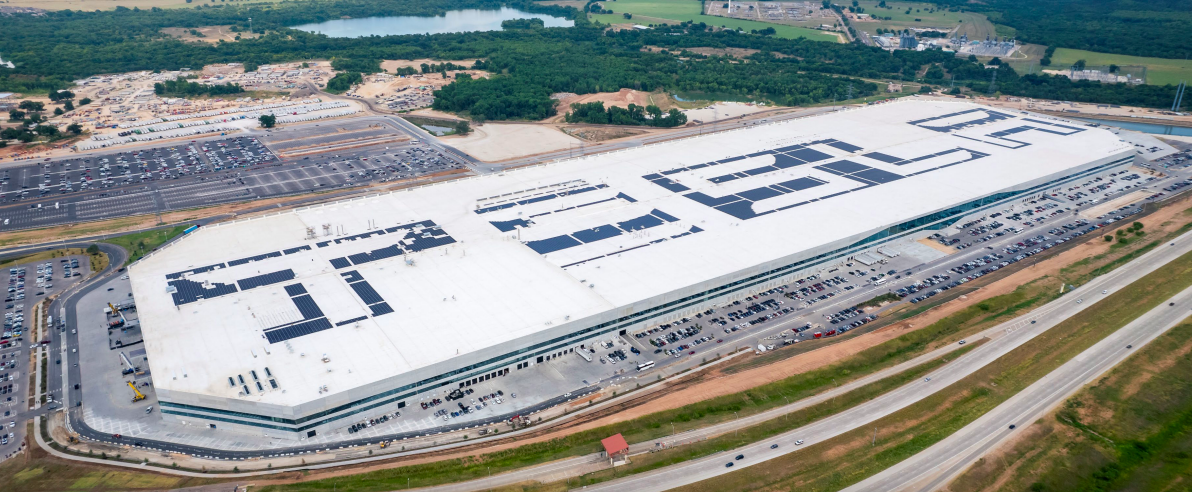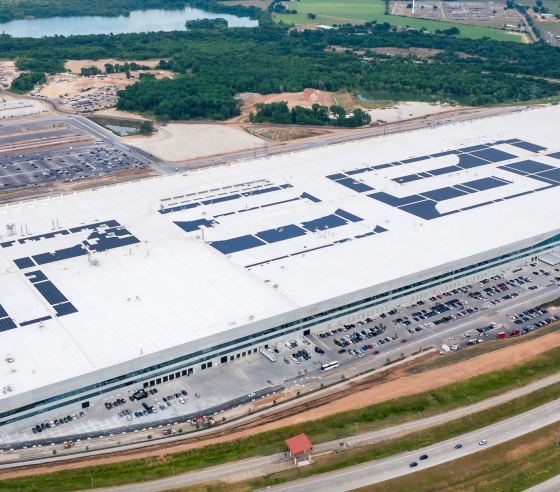Tesla has removed wording about having a “majority-minority” workforce in its latest 10-K filing, following recent statements from CEO Elon Musk opposing Diversity, Equity and Inclusion (DEI) initiatives—and a history of allegations of racial discrimination at the automaker’s factories.
In Tesla’s 10-K filing released on Monday, the automaker has changed some of the wording alluding to DEI measures at the company, instead adding a few new paragraphs at the end. The omitted wording from the prior year’s annual report, which can be found near the end of the Item 1, Business section of Tesla’s 10-K filing last year, reads as follows:
“With a majority-minority workforce, empowering our employee resource groups to take charge in driving initiatives that attract, develop and retain our passionate workforce is vital to our continued success.”
Both this and last year’s filings include the same opening line for the section:
“At Tesla, our employees show up passionate about making a difference in the world and for each other.”
However, instead of the “minority-majority” workforce phrasing included in last year’s filing, the 10-K filed this week includes the following language:
“We remain unwavering in our demand that our factories, offices, stores and service centers are places where our employees feel respected and appreciated. Our policies are designed to promote fairness and respect for everyone. We hire, evaluate and promote employees based on their skills and performance. Everyone is expected to be trustworthy, demonstrate excellence in their performance and collaborate with others. With this in mind, we will not tolerate certain behaviors. These include harassment, retaliation, violence, intimidation and discrimination of any kind on the basis of race, color, religion, national origin, gender, sexual orientation, gender identity, gender expression, age, disability or veteran status.”
The filing goes on to mention Tesla’s anti-harassment training and leadership development programs, encouraging employees to speak up about misconduct by contacting the company integrity line, human resources, and managers, or by submitting concerns through the Take Charge process.
You can see Tesla’s full 10-K filing for the fiscal year 2023 here, along with its 10-K released a year ago for the fiscal year 2022 here. Although the “majority-minority” workplace phrasing has been removed from the 10-K filing, Tesla still says this on its website, adding that underrepresented groups represent 67 percent of the company’s U.S. workforce.
Musk and Tesla have also continually emphasized their opposition to racism in the workplace in response to allegations of discrimination over the years. Musk has instead recently made several statements on X calling DEI initiatives racist, even noting in December that he thinks “DEI must DIE.”
“The point was to end discrimination, not replace it with different discrimination,” Musk added.
“Diversity, Equity and Inclusion” are propaganda words for racism, sexism and other -isms.
This is just as morally wrong as any other racism and sexism. Changing the target class doesn’t make it right!
— Elon Musk (@elonmusk) December 16, 2023
Earlier this month, Musk reiterated his opposition to these programs, saying that “DEI is just another word for racism.”
Discrimination on the basis of race, which DEI does, is literally the definition of racism
— Elon Musk (@elonmusk) January 3, 2024
Musk has also opposed what he terms the “woke mind virus,” which he has criticized several times over the past few years.
Yeah, we have a lot to fix. The Internet is infested with the woke mind virus.
— Elon Musk (@elonmusk) January 11, 2024
Tesla has also faced multiple court cases alleging racial discrimination in the past, each of which the company and Musk have denied.
One such case included the high-profile trial of former contracted elevator operator Owen Diaz, who was denied his appeal by a judge in October for a third re-trial after being awarded $137 million by a jury in 2021. Diaz had worked at Tesla’s factory in Fremont, California, in 2015, and a second jury last April awarded him a $3.2 million verdict after he rejected a lowered settlement of $15 million from the first trial.
In a lawsuit in California in 2022, the Department of Fair Employment and Housing (DFEH) accused Tesla of operating a “racially segregated” workplace at the Fremont factory, to which the automaker responded by denying the claims and filing a formal complaint against the agency.
Earlier this month, Musk paid a visit to the Auschwitz concentration camp, and to a symposium opposing the rise of anti-semitism organized by the European Jewish Association (EJA), after X faced advertising boycotts and heavy criticism when Musk liked and replied to an anti-semitic post in November.
“I’m sorry for that post. It was foolish of me,” Musk said in an interview following the incident. “Of my 30,000 posts, it might literally be the worst and dumbest post I’ve ever done. I think over time it’ll be obvious that I’m far from anti-semitic.”
Tesla accused of race-based discrimination, retaliation by former HR manager
What are your thoughts? Let me know at zach@teslarati.com, find me on X at @zacharyvisconti, or send your tips to us at tips@teslarati.com.

News
Tesla FSD fleet is nearing 7 billion total miles, including 2.5 billion city miles
As can be seen on Tesla’s official FSD webpage, vehicles equipped with the system have now navigated over 6.99 billion miles.

Tesla’s Full Self-Driving (Supervised) fleet is closing in on almost 7 billion total miles driven, as per data posted by the company on its official FSD webpage.
These figures hint at the massive scale of data fueling Tesla’s rapid FSD improvements, which have been quite notable as of late.
FSD mileage milestones
As can be seen on Tesla’s official FSD webpage, vehicles equipped with the system have now navigated over 6.99 billion miles. Tesla owner and avid FSD tester Whole Mars Catalog also shared a screenshot indicating that from the nearly 7 billion miles traveled by the FSD fleet, more than 2.5 billion miles were driven inside cities.
City miles are particularly valuable for complex urban scenarios like unprotected turns, pedestrian interactions, and traffic lights. This is also the difference-maker for FSD, as only complex solutions, such as Waymo’s self-driving taxis, operate similarly on inner-city streets. And even then, incidents such as the San Francisco blackouts have proven challenging for sensor-rich vehicles like Waymos.
Tesla’s data edge
Tesla has a number of advantages in the autonomous vehicle sector, one of which is the size of its fleet and the number of vehicles training FSD on real-world roads. Tesla’s nearly 7 billion FSD miles then allow the company to roll out updates that make its vehicles behave like they are being driven by experienced drivers, even if they are operating on their own.
So notable are Tesla’s improvements to FSD that NVIDIA Director of Robotics Jim Fan, after experiencing FSD v14, noted that the system is the first AI that passes what he described as a “Physical Turing Test.”
“Despite knowing exactly how robot learning works, I still find it magical watching the steering wheel turn by itself. First it feels surreal, next it becomes routine. Then, like the smartphone, taking it away actively hurts. This is how humanity gets rewired and glued to god-like technologies,” Fan wrote in a post on X.
News
Tesla starts showing how FSD will change lives in Europe
Local officials tested the system on narrow country roads and were impressed by FSD’s smooth, human-like driving, with some calling the service a game-changer for everyday life in areas that are far from urban centers.

Tesla has launched Europe’s first public shuttle service using Full Self-Driving (Supervised) in the rural Eifelkreis Bitburg-Prüm region of Germany, demonstrating how the technology can restore independence and mobility for people who struggle with limited transport options.
Local officials tested the system on narrow country roads and were impressed by FSD’s smooth, human-like driving, with some calling the service a game-changer for everyday life in areas that are far from urban centers.
Officials see real impact on rural residents
Arzfeld Mayor Johannes Kuhl and District Administrator Andreas Kruppert personally tested the Tesla shuttle service. This allowed them to see just how well FSD navigated winding lanes and rural roads confidently. Kruppert said, “Autonomous driving sounds like science fiction to many, but we simply see here that it works totally well in rural regions too.” Kuhl, for his part, also noted that FSD “feels like a very experienced driver.”
The pilot complements the area’s “Citizen Bus” program, which provides on-demand rides for elderly residents who can no longer drive themselves. Tesla Europe shared a video of a demonstration of the service, highlighting how FSD gives people their freedom back, even in places where public transport is not as prevalent.
What the Ministry for Economic Affairs and Transport says
Rhineland-Palatinate’s Minister Daniela Schmitt supported the project, praising the collaboration that made this “first of its kind in Europe” possible. As per the ministry, the rural rollout for the service shows FSD’s potential beyond major cities, and it delivers tangible benefits like grocery runs, doctor visits, and social connections for isolated residents.
“Reliable and flexible mobility is especially vital in rural areas. With the launch of a shuttle service using self-driving vehicles (FSD supervised) by Tesla in the Eifelkreis Bitburg-Prüm, an innovative pilot project is now getting underway that complements local community bus services. It is the first project of its kind in Europe.
“The result is a real gain for rural mobility: greater accessibility, more flexibility and tangible benefits for everyday life. A strong signal for innovation, cooperation and future-oriented mobility beyond urban centers,” the ministry wrote in a LinkedIn post.
News
Tesla China quietly posts Robotaxi-related job listing
Tesla China is currently seeking a Low Voltage Electrical Engineer to work on circuit board design for the company’s autonomous vehicles.

Tesla has posted a new job listing in Shanghai explicitly tied to its Robotaxi program, fueling speculation that the company is preparing to launch its dedicated autonomous ride-hailing service in China.
As noted in the listing, Tesla China is currently seeking a Low Voltage Electrical Engineer to work on circuit board design for the company’s autonomous vehicles.
Robotaxi-specific role
The listing, which was shared on social media platform X by industry watcher @tslaming, suggested that Tesla China is looking to fill the role urgently. The job listing itself specifically mentions that the person hired for the role will be working on the Low Voltage Hardware team, which would design the circuit boards that would serve as the nervous system of the Robotaxi.
Key tasks for the role, as indicated in the job listing, include collaboration with PCB layout, firmware, mechanical, program management, and validation teams, among other responsibilities. The role is based in Shanghai.
China Robotaxi launch
China represents a massive potential market for robotaxis, with its dense urban centers and supportive policies in select cities. Tesla has limited permission to roll out FSD in the country, though despite this, its vehicles have been hailed as among the best in the market when it comes to autonomous features. So far, at least, it appears that China supports Tesla’s FSD and Robotaxi rollout.
This was hinted at in November, when Tesla brought the Cybercab to the 8th China International Import Expo (CIIE) in Shanghai, marking the first time that the autonomous two-seater was brought to the Asia-Pacific region. The vehicle, despite not having a release date in China, received a significant amount of interest among the event’s attendees.










